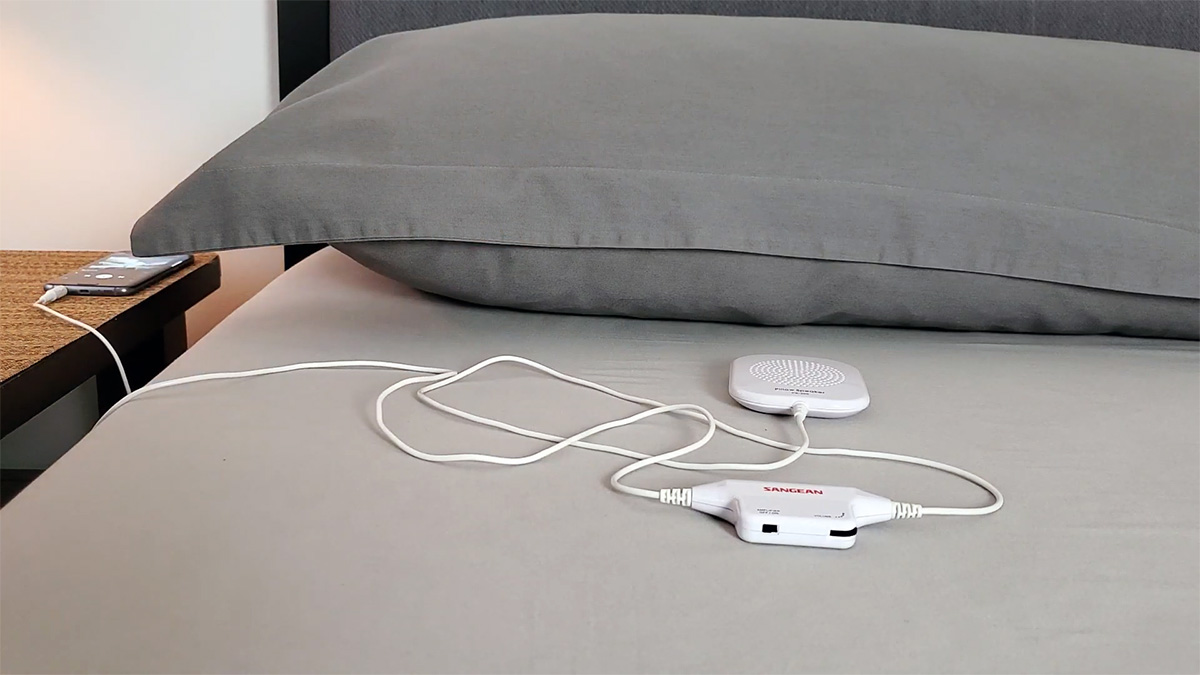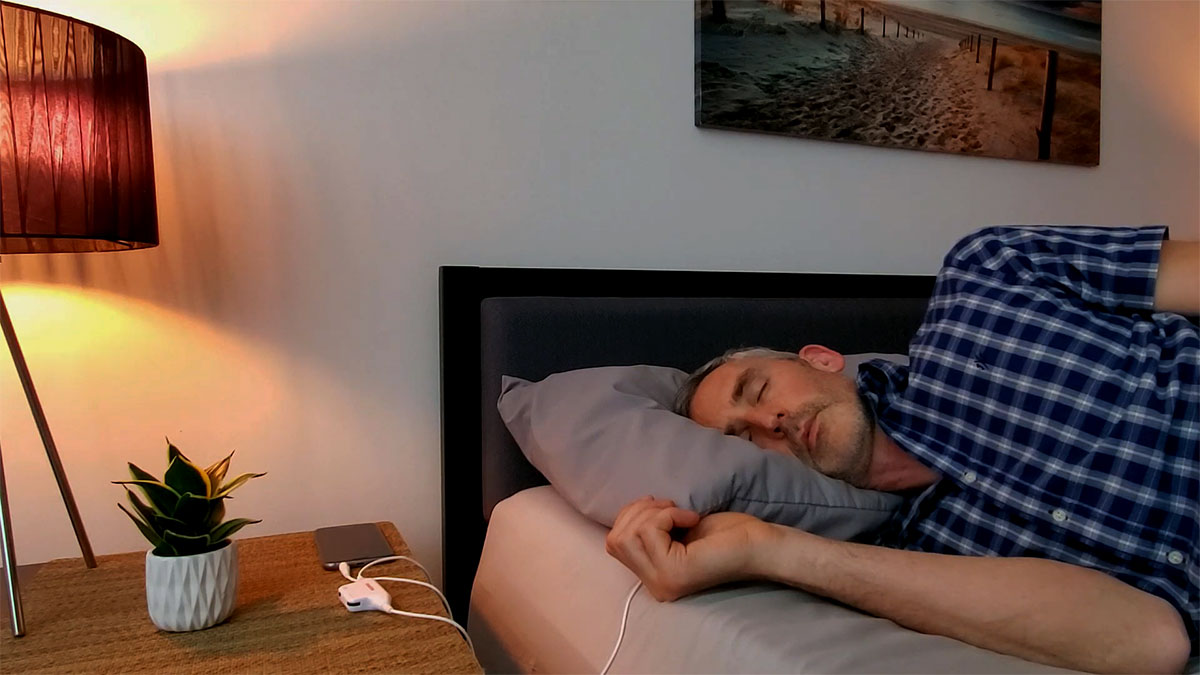Disclosure: This website is supported by my readers. If you choose to buy a product after clicking a link, I may receive a commission, at no extra cost to you. Learn more.
Summary
The Sangean PS-300 is a small pillow speaker that will allow you to listen privately to music, radio, podcasts, or television in bed. It’s a comfortable alternative to wearing headphones, especially if you sleep on your side during the night.
The volume is loud enough so that you can listen in private, but not too loud that you accidentally disturb anyone else. It has an in-line volume control and a small amplifier, so you can easily adjust the volume while still half asleep.
Pros
- Flexible placement: you can put it under or on top of your pillow.
- Convenient in-line volume control.
- The cable is 120cm long, which will easily reach a nightstand or table.
- There’s an AAA battery-operated amplifier to boost the volume, or you can use it without the amp and battery.
- The speaker is flat so you don’t feel it through the pillow.
- Reasonable price (I paid $30).
Cons
- If you have a very dense or thick pillow, the sound might be too quiet.
- Bass in music distorts when the volume is turned up.
- Won’t block out external sounds in the home.
Video transcript and full review
Please note that this written article isn’t an exact transcript of my video review above. I’ve edited some parts to make it easier to read and added some points where relevant.

Introduction
Hi, this is Ethan from No Sleepless Nights. And in this review, I’m going to be talking about the Sangean pillow speaker, specifically the PS-300 model.
They make a couple of different ones, but I like this one because it’s very flat, thin and small. So you can slide it underneath your pillow and listen to your music, radio, podcast or TV quietly in bed without disturbing your partner.
And that’s great if your partner doesn’t want to listen to your music or your radio. Perhaps they need silence to sleep, or they just don’t like your choice of music, which happens sometimes.

Volume control, amplifier, headphone jack and cable
With the speaker, you have an inline volume control so you don’t need to alter the volume on your device on the nightstand. And it has a built-in amplifier, which will make the music or your radio a bit louder.
It connects with a 3.5 millimeter pin, so you need a standard headphone jack. And that means that it will be fine for most televisions and radios, and a lot of smartphones and tablets. But some of the latest Apple devices will need an adapter now.
The cable is 120 cm long, which is easily long enough to stretch from under the pillow to a nightstand or table.
Power output
I think with pillow speakers in general, it’s really important to have reasonable expectations of what you’re going to get. I paid $30 for this one, which is a lot less than you would pay for a high-quality speaker or headphones.
The maximum power output of the PS-300 is 50 microwatts, and the speaker itself is a modest 57 millimeters. But the idea is that it just plays music quietly, so it doesn’t need to be a massive speaker. And that means it’s relatively cheap, which is a good thing.
Now let’s have a look at the components closer, and then I’ll play some music and some radio through it so you can listen to it. I’ll show you some positioning choices and then give you my final verdict.
A close-up look at the controls, and listening to music and podcasts
The pillow speaker is quite small and flat as I already explained. You have an inline volume control which is a short distance down the cable, and is convenient to use.
The control also has a small amplifier. But if you use the amplifier, then you’re going to need one AAA battery. However, you don’t need to use the amplifier as the speaker will still work fine without it.
So let’s start with a BBC podcast (in this case, a woman speaking). You can hear her speaking clearly, which is good. But you can hear that the Bass is slightly distorted with the amplifier on. So you need to be careful there.
And here’s a Mozart piece. With classical music, it tends to sound really nice through the pillow speaker – once you get the volume right. Again, In fact, you can turn the amplifier off and turn the volume up with classical music and it sounds pretty good in my experience.
And one final example – this is a good example of what happens if you put a song with a little bass through a pillow speaker, which I’m not going to do for very long.
So if I have it on with no amplifier, it sounds absolutely fine. But if I turn the amplifier on, you can immediately hear that bad things happen to the speaker!
You really can’t put base heavy songs through a little pillow speaker. You need to listen to very quiet music, soft and gentle music, music without heavy bass. And if you do put songs on with lots of bass, then you need to keep the amplifier off or turn the volume right down.
So that’s the speaker in action, now let’s go through to the bedroom and I’ll show you some positioning choices, how to set it up and get the best out of it underneath the pillow.
Setting the pillow speaker up in bed

When you’re ready for bed, the basic way to set up the Sangean pillow speaker is really simple. Just take the cable and plug it into the 3.5 mm headphone jack on your audio device, which you can then pop out the way in the nightstand.
Then you slide the speaker itself underneath your pillow, roughly where you think your head’s going to be – at least when you start the night.
Then you’ve got all this cable, which is great if your nightstand is really far away. But if not, then you can drop it into the gap between the mattress and your nightstand, and then slide the volume control and the cable underneath your pillow.
Or if you prefer not to have much cable underneath the pillow with you, you can have the inline volume control over on the nightstand, and work out what to do with all that cable, basically!
How your pillow and position in bed affect the sound

Something to bear in mind is that your pillow choice and position make a difference. If you lie on your side you can generally hear it – even through a dense pillow. But if you lie on your back, on a thick and dense pillow, you’re going to struggle to hear it.
One alternative I found if you have a particularly huge pillow, is that you pop the pillow speaker inside the pillowcase on top instead. Then you can have it right next to your ear. And that just means that it’s easier to listen to.
However, you might find that slightly uncomfortable in the night. In which case, my recommendation is to get rid of that giant pillow, and find yourself a smaller, lighter or thinner one. Potentially all three of those things!
And then when you lie on your side, you can hear the music and people talking really nicely through the pillow. And even if you lie on your back, I’ve found that if the pillow is small enough and light enough, you can hear talking as well, which is great.
Verdict
All in all, I think the Sangean PS-300 pillow speaker is a useful little device if you want to listen to your music or radio quietly in bed without disturbing a partner.
And really, I think there’s a very limited chance that you’re going to disturb your partner. Partly because of that quiet volume, and also because ideally you’re going to have it buried underneath your pillow.
I’ve used it with my partner many times. And even in the night time when she’s half asleep and I pull the pillow speaker out from underneath my pillow to change the position, and the sound is then in the room, she doesn’t hear it or wake up – it’s that quiet.
However, when you have it underneath your pillow and it’s a decent-sized pillow – it’s not too thick or dense – and you’re lying with your ear roughly over the top of the pillow speaker, then you can hear it nicely. And then you can relax, you can enjoy it, and hopefully fall asleep.
But again, as I said in the beginning, it’s important to have reasonable expectations of the sound quality and the volume. Thanks for watching (and reading!).




